Healthcare Ethics and Safety in Aged Care
VerifiedAdded on 2020/11/23
|12
|3034
|66
Literature Review
AI Summary
This assignment delves into the crucial intersection of ethics and safety within the field of aged care. It examines various challenges, including maintaining patient confidentiality, preventing elder abuse, ensuring safe medication practices, promoting occupational health for caregivers, and upholding ethical standards in medical education. The provided readings offer diverse perspectives on these issues, prompting critical reflection and analysis.
Contribute Materials
Your contribution can guide someone’s learning journey. Share your
documents today.
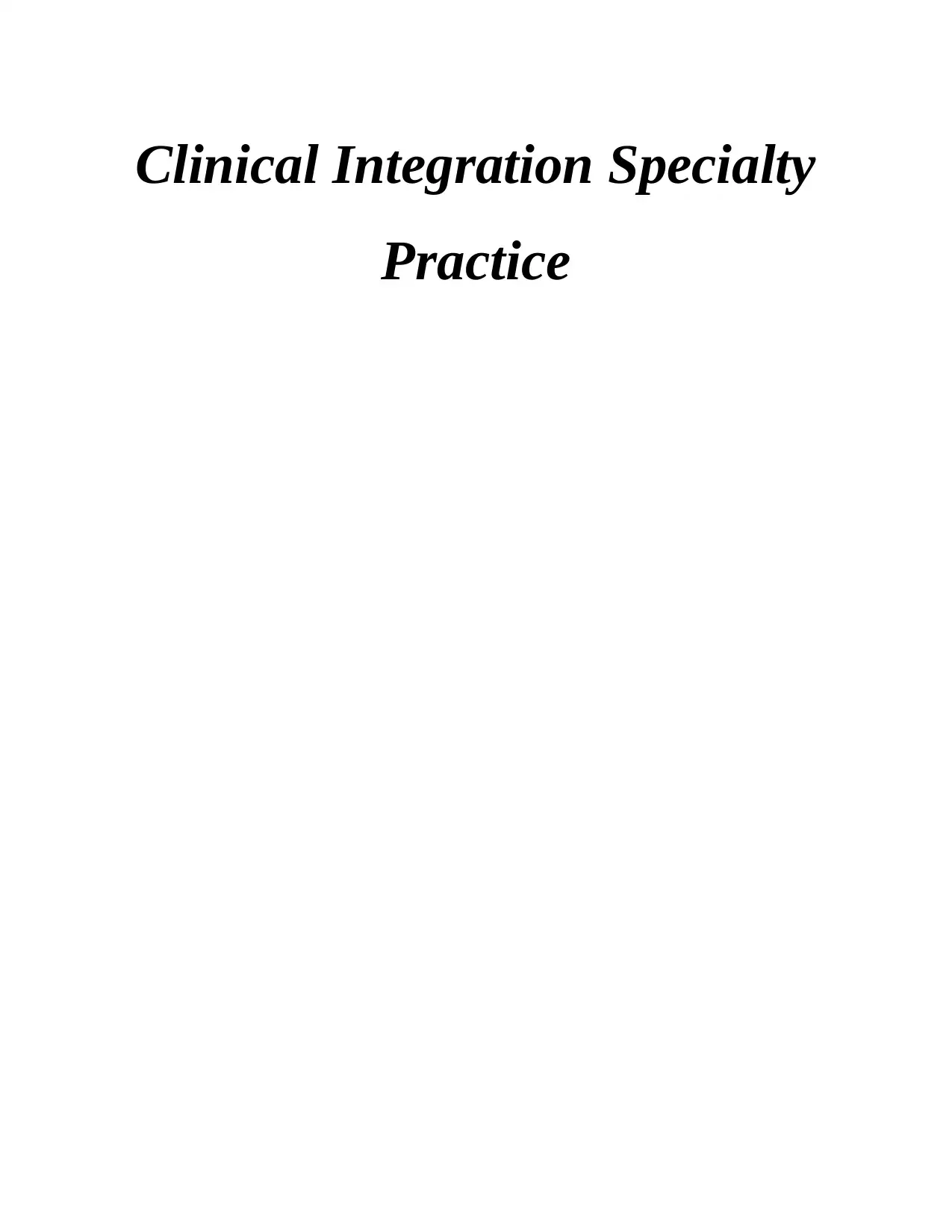
Clinical Integration Specialty
Practice
Practice
Secure Best Marks with AI Grader
Need help grading? Try our AI Grader for instant feedback on your assignments.

TABLE OF CONTENTS
INTRODUCTION...........................................................................................................................1
PART A- MODULE 1.....................................................................................................................1
Safety......................................................................................................................................1
MODULE 2: CONFIDENTIALITY...............................................................................................3
Confidentiality........................................................................................................................3
Presenting implications and dilemmas legally and ethically..................................................3
Impact and consequences for not maintaining confidentiality...............................................4
PART B: MODULE 3.....................................................................................................................4
Reflection using Five R's........................................................................................................4
REFERENCES................................................................................................................................8
INTRODUCTION...........................................................................................................................1
PART A- MODULE 1.....................................................................................................................1
Safety......................................................................................................................................1
MODULE 2: CONFIDENTIALITY...............................................................................................3
Confidentiality........................................................................................................................3
Presenting implications and dilemmas legally and ethically..................................................3
Impact and consequences for not maintaining confidentiality...............................................4
PART B: MODULE 3.....................................................................................................................4
Reflection using Five R's........................................................................................................4
REFERENCES................................................................................................................................8
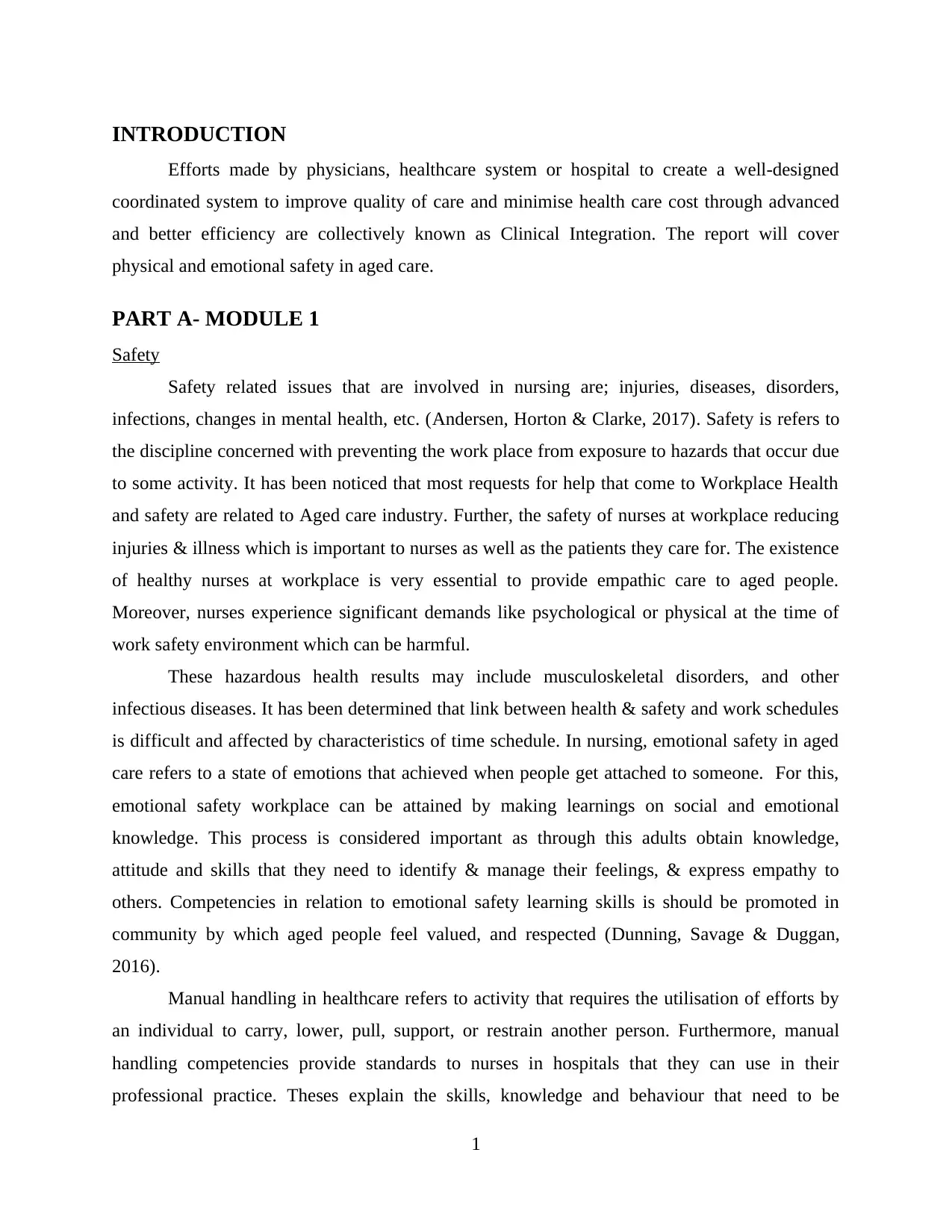
INTRODUCTION
Efforts made by physicians, healthcare system or hospital to create a well-designed
coordinated system to improve quality of care and minimise health care cost through advanced
and better efficiency are collectively known as Clinical Integration. The report will cover
physical and emotional safety in aged care.
PART A- MODULE 1
Safety
Safety related issues that are involved in nursing are; injuries, diseases, disorders,
infections, changes in mental health, etc. (Andersen, Horton & Clarke, 2017). Safety is refers to
the discipline concerned with preventing the work place from exposure to hazards that occur due
to some activity. It has been noticed that most requests for help that come to Workplace Health
and safety are related to Aged care industry. Further, the safety of nurses at workplace reducing
injuries & illness which is important to nurses as well as the patients they care for. The existence
of healthy nurses at workplace is very essential to provide empathic care to aged people.
Moreover, nurses experience significant demands like psychological or physical at the time of
work safety environment which can be harmful.
These hazardous health results may include musculoskeletal disorders, and other
infectious diseases. It has been determined that link between health & safety and work schedules
is difficult and affected by characteristics of time schedule. In nursing, emotional safety in aged
care refers to a state of emotions that achieved when people get attached to someone. For this,
emotional safety workplace can be attained by making learnings on social and emotional
knowledge. This process is considered important as through this adults obtain knowledge,
attitude and skills that they need to identify & manage their feelings, & express empathy to
others. Competencies in relation to emotional safety learning skills is should be promoted in
community by which aged people feel valued, and respected (Dunning, Savage & Duggan,
2016).
Manual handling in healthcare refers to activity that requires the utilisation of efforts by
an individual to carry, lower, pull, support, or restrain another person. Furthermore, manual
handling competencies provide standards to nurses in hospitals that they can use in their
professional practice. Theses explain the skills, knowledge and behaviour that need to be
1
Efforts made by physicians, healthcare system or hospital to create a well-designed
coordinated system to improve quality of care and minimise health care cost through advanced
and better efficiency are collectively known as Clinical Integration. The report will cover
physical and emotional safety in aged care.
PART A- MODULE 1
Safety
Safety related issues that are involved in nursing are; injuries, diseases, disorders,
infections, changes in mental health, etc. (Andersen, Horton & Clarke, 2017). Safety is refers to
the discipline concerned with preventing the work place from exposure to hazards that occur due
to some activity. It has been noticed that most requests for help that come to Workplace Health
and safety are related to Aged care industry. Further, the safety of nurses at workplace reducing
injuries & illness which is important to nurses as well as the patients they care for. The existence
of healthy nurses at workplace is very essential to provide empathic care to aged people.
Moreover, nurses experience significant demands like psychological or physical at the time of
work safety environment which can be harmful.
These hazardous health results may include musculoskeletal disorders, and other
infectious diseases. It has been determined that link between health & safety and work schedules
is difficult and affected by characteristics of time schedule. In nursing, emotional safety in aged
care refers to a state of emotions that achieved when people get attached to someone. For this,
emotional safety workplace can be attained by making learnings on social and emotional
knowledge. This process is considered important as through this adults obtain knowledge,
attitude and skills that they need to identify & manage their feelings, & express empathy to
others. Competencies in relation to emotional safety learning skills is should be promoted in
community by which aged people feel valued, and respected (Dunning, Savage & Duggan,
2016).
Manual handling in healthcare refers to activity that requires the utilisation of efforts by
an individual to carry, lower, pull, support, or restrain another person. Furthermore, manual
handling competencies provide standards to nurses in hospitals that they can use in their
professional practice. Theses explain the skills, knowledge and behaviour that need to be
1

implemented by them to reduce manual handling danger to themselves & others. Injuries that can
be caused due to manual handling can be acute trauma which include fractures or cuts. Also, the
most common causes are; workplace injuries and back pain. It has been discovered that, the
competencies standards aim to provide:
Standards that are clear and consistent, for which nurses should be able to do this within
their practice in aged care associated with manual handling (Oakman & Bartram, 2017).
It also provides an in built risk management approach for health care nurses to manual
handling, that will inform knowledge and learning assets.
Safety in aged care is considered very important component of quality nursing care.
However, it has been seen that the care system is full of errors, and can be damaging to safe
patient care (Emotional Safety, 2018). Yet, in today's world, healthcare providers face many
issues in care environment, while trying to keep their patients safe. Here are some strategies that
can be followed by nurses to prevent injuries:
Become familiar: - It is necessary for nurses to become familiar with aged patients, this
will help them to move patients safely and bring them closer emotionally as well. Nurses
should make efforts to understand patient's feelings, thoughts and emotions, so that they
can take care for them easily.
Provide safe companion: - It has been suggested that hospitals must increase safety
companions for patients who find it difficult to follow directions (Jeon et al., 2015).
Do safety rounds: - It is considered one of the most effective strategies, which should be
used to prevent falls, for which safety rounds should be conducted twice a day.
2
be caused due to manual handling can be acute trauma which include fractures or cuts. Also, the
most common causes are; workplace injuries and back pain. It has been discovered that, the
competencies standards aim to provide:
Standards that are clear and consistent, for which nurses should be able to do this within
their practice in aged care associated with manual handling (Oakman & Bartram, 2017).
It also provides an in built risk management approach for health care nurses to manual
handling, that will inform knowledge and learning assets.
Safety in aged care is considered very important component of quality nursing care.
However, it has been seen that the care system is full of errors, and can be damaging to safe
patient care (Emotional Safety, 2018). Yet, in today's world, healthcare providers face many
issues in care environment, while trying to keep their patients safe. Here are some strategies that
can be followed by nurses to prevent injuries:
Become familiar: - It is necessary for nurses to become familiar with aged patients, this
will help them to move patients safely and bring them closer emotionally as well. Nurses
should make efforts to understand patient's feelings, thoughts and emotions, so that they
can take care for them easily.
Provide safe companion: - It has been suggested that hospitals must increase safety
companions for patients who find it difficult to follow directions (Jeon et al., 2015).
Do safety rounds: - It is considered one of the most effective strategies, which should be
used to prevent falls, for which safety rounds should be conducted twice a day.
2
Secure Best Marks with AI Grader
Need help grading? Try our AI Grader for instant feedback on your assignments.
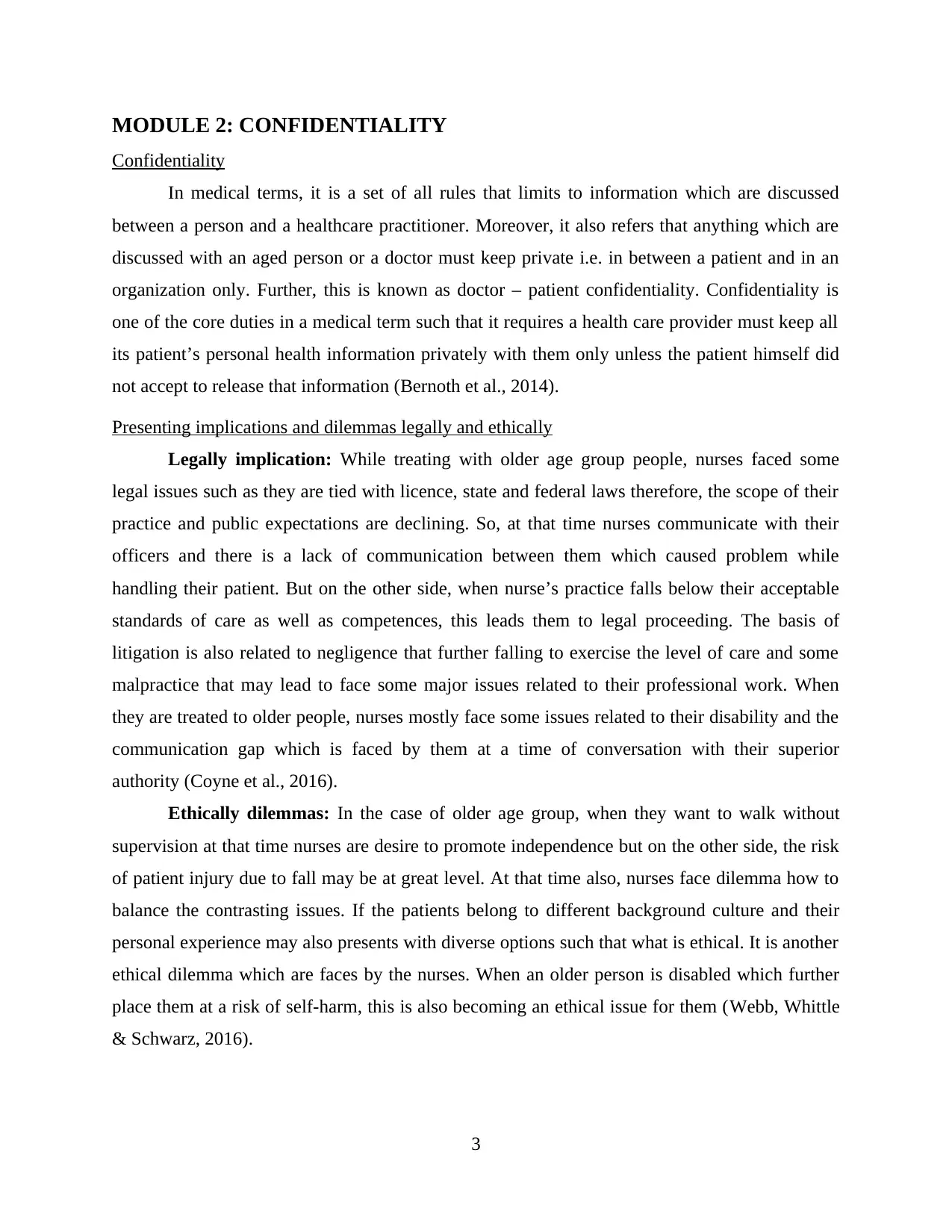
MODULE 2: CONFIDENTIALITY
Confidentiality
In medical terms, it is a set of all rules that limits to information which are discussed
between a person and a healthcare practitioner. Moreover, it also refers that anything which are
discussed with an aged person or a doctor must keep private i.e. in between a patient and in an
organization only. Further, this is known as doctor – patient confidentiality. Confidentiality is
one of the core duties in a medical term such that it requires a health care provider must keep all
its patient’s personal health information privately with them only unless the patient himself did
not accept to release that information (Bernoth et al., 2014).
Presenting implications and dilemmas legally and ethically
Legally implication: While treating with older age group people, nurses faced some
legal issues such as they are tied with licence, state and federal laws therefore, the scope of their
practice and public expectations are declining. So, at that time nurses communicate with their
officers and there is a lack of communication between them which caused problem while
handling their patient. But on the other side, when nurse’s practice falls below their acceptable
standards of care as well as competences, this leads them to legal proceeding. The basis of
litigation is also related to negligence that further falling to exercise the level of care and some
malpractice that may lead to face some major issues related to their professional work. When
they are treated to older people, nurses mostly face some issues related to their disability and the
communication gap which is faced by them at a time of conversation with their superior
authority (Coyne et al., 2016).
Ethically dilemmas: In the case of older age group, when they want to walk without
supervision at that time nurses are desire to promote independence but on the other side, the risk
of patient injury due to fall may be at great level. At that time also, nurses face dilemma how to
balance the contrasting issues. If the patients belong to different background culture and their
personal experience may also presents with diverse options such that what is ethical. It is another
ethical dilemma which are faces by the nurses. When an older person is disabled which further
place them at a risk of self-harm, this is also becoming an ethical issue for them (Webb, Whittle
& Schwarz, 2016).
3
Confidentiality
In medical terms, it is a set of all rules that limits to information which are discussed
between a person and a healthcare practitioner. Moreover, it also refers that anything which are
discussed with an aged person or a doctor must keep private i.e. in between a patient and in an
organization only. Further, this is known as doctor – patient confidentiality. Confidentiality is
one of the core duties in a medical term such that it requires a health care provider must keep all
its patient’s personal health information privately with them only unless the patient himself did
not accept to release that information (Bernoth et al., 2014).
Presenting implications and dilemmas legally and ethically
Legally implication: While treating with older age group people, nurses faced some
legal issues such as they are tied with licence, state and federal laws therefore, the scope of their
practice and public expectations are declining. So, at that time nurses communicate with their
officers and there is a lack of communication between them which caused problem while
handling their patient. But on the other side, when nurse’s practice falls below their acceptable
standards of care as well as competences, this leads them to legal proceeding. The basis of
litigation is also related to negligence that further falling to exercise the level of care and some
malpractice that may lead to face some major issues related to their professional work. When
they are treated to older people, nurses mostly face some issues related to their disability and the
communication gap which is faced by them at a time of conversation with their superior
authority (Coyne et al., 2016).
Ethically dilemmas: In the case of older age group, when they want to walk without
supervision at that time nurses are desire to promote independence but on the other side, the risk
of patient injury due to fall may be at great level. At that time also, nurses face dilemma how to
balance the contrasting issues. If the patients belong to different background culture and their
personal experience may also presents with diverse options such that what is ethical. It is another
ethical dilemma which are faces by the nurses. When an older person is disabled which further
place them at a risk of self-harm, this is also becoming an ethical issue for them (Webb, Whittle
& Schwarz, 2016).
3
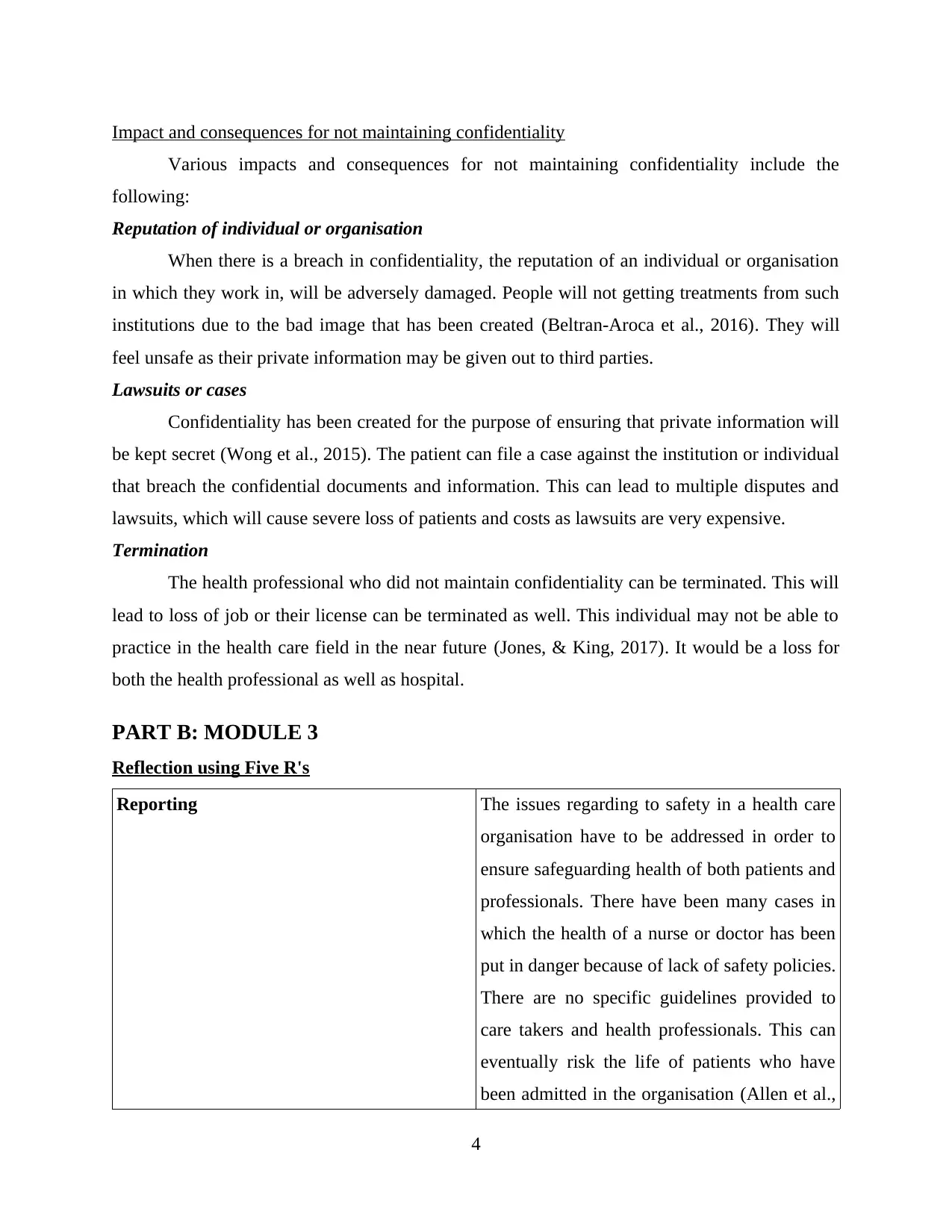
Impact and consequences for not maintaining confidentiality
Various impacts and consequences for not maintaining confidentiality include the
following:
Reputation of individual or organisation
When there is a breach in confidentiality, the reputation of an individual or organisation
in which they work in, will be adversely damaged. People will not getting treatments from such
institutions due to the bad image that has been created (Beltran-Aroca et al., 2016). They will
feel unsafe as their private information may be given out to third parties.
Lawsuits or cases
Confidentiality has been created for the purpose of ensuring that private information will
be kept secret (Wong et al., 2015). The patient can file a case against the institution or individual
that breach the confidential documents and information. This can lead to multiple disputes and
lawsuits, which will cause severe loss of patients and costs as lawsuits are very expensive.
Termination
The health professional who did not maintain confidentiality can be terminated. This will
lead to loss of job or their license can be terminated as well. This individual may not be able to
practice in the health care field in the near future (Jones, & King, 2017). It would be a loss for
both the health professional as well as hospital.
PART B: MODULE 3
Reflection using Five R's
Reporting The issues regarding to safety in a health care
organisation have to be addressed in order to
ensure safeguarding health of both patients and
professionals. There have been many cases in
which the health of a nurse or doctor has been
put in danger because of lack of safety policies.
There are no specific guidelines provided to
care takers and health professionals. This can
eventually risk the life of patients who have
been admitted in the organisation (Allen et al.,
4
Various impacts and consequences for not maintaining confidentiality include the
following:
Reputation of individual or organisation
When there is a breach in confidentiality, the reputation of an individual or organisation
in which they work in, will be adversely damaged. People will not getting treatments from such
institutions due to the bad image that has been created (Beltran-Aroca et al., 2016). They will
feel unsafe as their private information may be given out to third parties.
Lawsuits or cases
Confidentiality has been created for the purpose of ensuring that private information will
be kept secret (Wong et al., 2015). The patient can file a case against the institution or individual
that breach the confidential documents and information. This can lead to multiple disputes and
lawsuits, which will cause severe loss of patients and costs as lawsuits are very expensive.
Termination
The health professional who did not maintain confidentiality can be terminated. This will
lead to loss of job or their license can be terminated as well. This individual may not be able to
practice in the health care field in the near future (Jones, & King, 2017). It would be a loss for
both the health professional as well as hospital.
PART B: MODULE 3
Reflection using Five R's
Reporting The issues regarding to safety in a health care
organisation have to be addressed in order to
ensure safeguarding health of both patients and
professionals. There have been many cases in
which the health of a nurse or doctor has been
put in danger because of lack of safety policies.
There are no specific guidelines provided to
care takers and health professionals. This can
eventually risk the life of patients who have
been admitted in the organisation (Allen et al.,
4

2016). I, as a professional in healthcare, it is
my responsibility to report such happenings to
the health governance, so that we all can work
together to prevent risks and improve the
safety and quality in our organisation.
5
my responsibility to report such happenings to
the health governance, so that we all can work
together to prevent risks and improve the
safety and quality in our organisation.
5
Paraphrase This Document
Need a fresh take? Get an instant paraphrase of this document with our AI Paraphraser
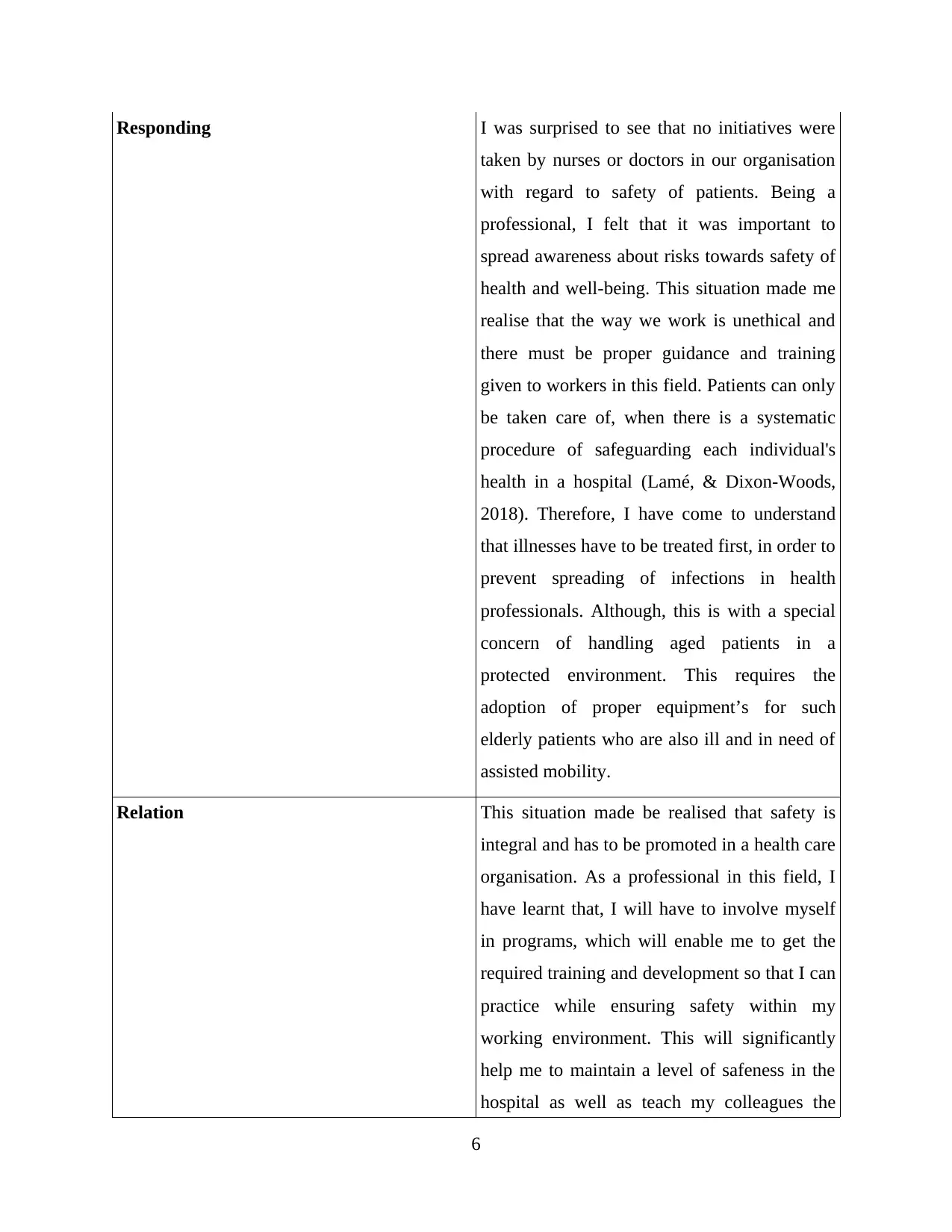
Responding I was surprised to see that no initiatives were
taken by nurses or doctors in our organisation
with regard to safety of patients. Being a
professional, I felt that it was important to
spread awareness about risks towards safety of
health and well-being. This situation made me
realise that the way we work is unethical and
there must be proper guidance and training
given to workers in this field. Patients can only
be taken care of, when there is a systematic
procedure of safeguarding each individual's
health in a hospital (Lamé, & Dixon-Woods,
2018). Therefore, I have come to understand
that illnesses have to be treated first, in order to
prevent spreading of infections in health
professionals. Although, this is with a special
concern of handling aged patients in a
protected environment. This requires the
adoption of proper equipment’s for such
elderly patients who are also ill and in need of
assisted mobility.
Relation This situation made be realised that safety is
integral and has to be promoted in a health care
organisation. As a professional in this field, I
have learnt that, I will have to involve myself
in programs, which will enable me to get the
required training and development so that I can
practice while ensuring safety within my
working environment. This will significantly
help me to maintain a level of safeness in the
hospital as well as teach my colleagues the
6
taken by nurses or doctors in our organisation
with regard to safety of patients. Being a
professional, I felt that it was important to
spread awareness about risks towards safety of
health and well-being. This situation made me
realise that the way we work is unethical and
there must be proper guidance and training
given to workers in this field. Patients can only
be taken care of, when there is a systematic
procedure of safeguarding each individual's
health in a hospital (Lamé, & Dixon-Woods,
2018). Therefore, I have come to understand
that illnesses have to be treated first, in order to
prevent spreading of infections in health
professionals. Although, this is with a special
concern of handling aged patients in a
protected environment. This requires the
adoption of proper equipment’s for such
elderly patients who are also ill and in need of
assisted mobility.
Relation This situation made be realised that safety is
integral and has to be promoted in a health care
organisation. As a professional in this field, I
have learnt that, I will have to involve myself
in programs, which will enable me to get the
required training and development so that I can
practice while ensuring safety within my
working environment. This will significantly
help me to maintain a level of safeness in the
hospital as well as teach my colleagues the
6
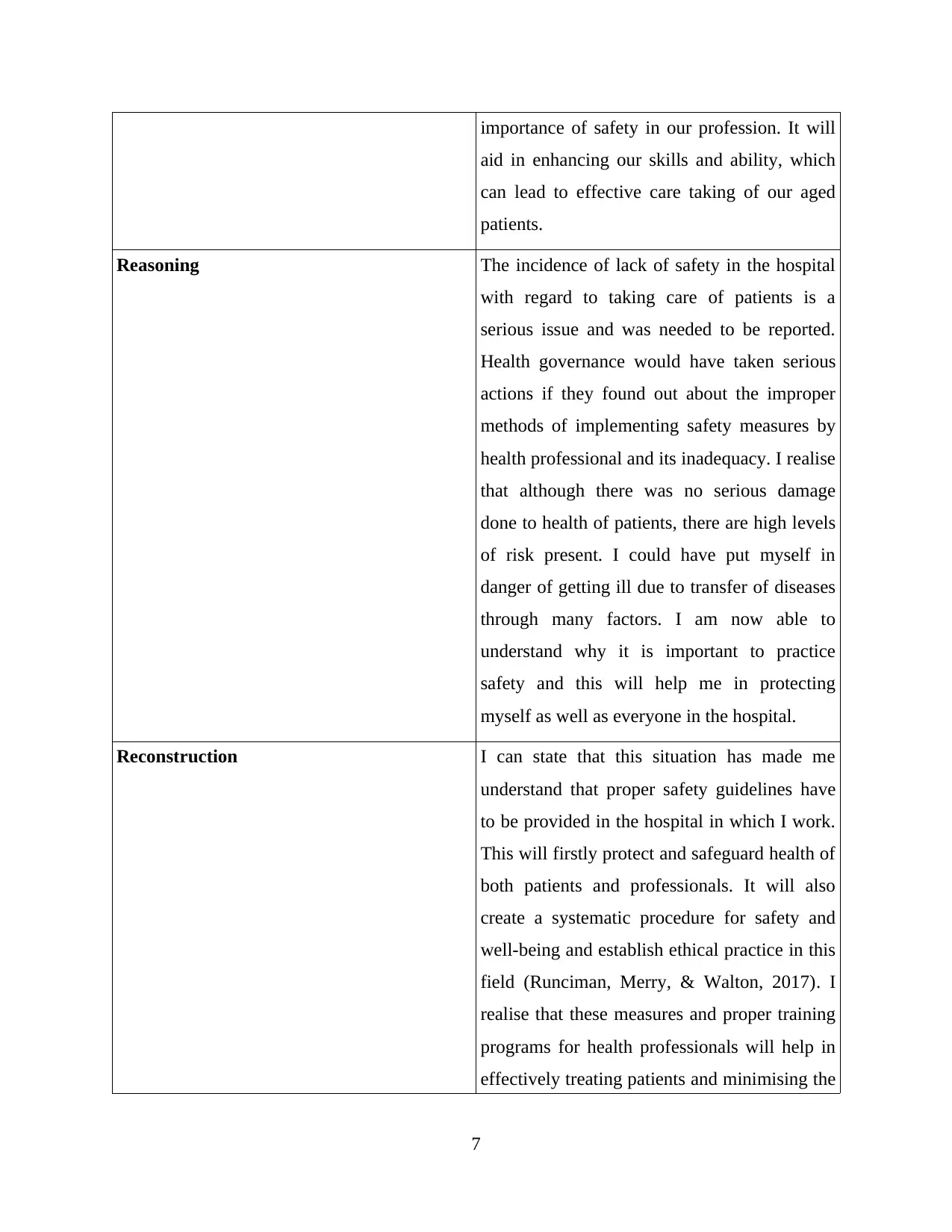
importance of safety in our profession. It will
aid in enhancing our skills and ability, which
can lead to effective care taking of our aged
patients.
Reasoning The incidence of lack of safety in the hospital
with regard to taking care of patients is a
serious issue and was needed to be reported.
Health governance would have taken serious
actions if they found out about the improper
methods of implementing safety measures by
health professional and its inadequacy. I realise
that although there was no serious damage
done to health of patients, there are high levels
of risk present. I could have put myself in
danger of getting ill due to transfer of diseases
through many factors. I am now able to
understand why it is important to practice
safety and this will help me in protecting
myself as well as everyone in the hospital.
Reconstruction I can state that this situation has made me
understand that proper safety guidelines have
to be provided in the hospital in which I work.
This will firstly protect and safeguard health of
both patients and professionals. It will also
create a systematic procedure for safety and
well-being and establish ethical practice in this
field (Runciman, Merry, & Walton, 2017). I
realise that these measures and proper training
programs for health professionals will help in
effectively treating patients and minimising the
7
aid in enhancing our skills and ability, which
can lead to effective care taking of our aged
patients.
Reasoning The incidence of lack of safety in the hospital
with regard to taking care of patients is a
serious issue and was needed to be reported.
Health governance would have taken serious
actions if they found out about the improper
methods of implementing safety measures by
health professional and its inadequacy. I realise
that although there was no serious damage
done to health of patients, there are high levels
of risk present. I could have put myself in
danger of getting ill due to transfer of diseases
through many factors. I am now able to
understand why it is important to practice
safety and this will help me in protecting
myself as well as everyone in the hospital.
Reconstruction I can state that this situation has made me
understand that proper safety guidelines have
to be provided in the hospital in which I work.
This will firstly protect and safeguard health of
both patients and professionals. It will also
create a systematic procedure for safety and
well-being and establish ethical practice in this
field (Runciman, Merry, & Walton, 2017). I
realise that these measures and proper training
programs for health professionals will help in
effectively treating patients and minimising the
7
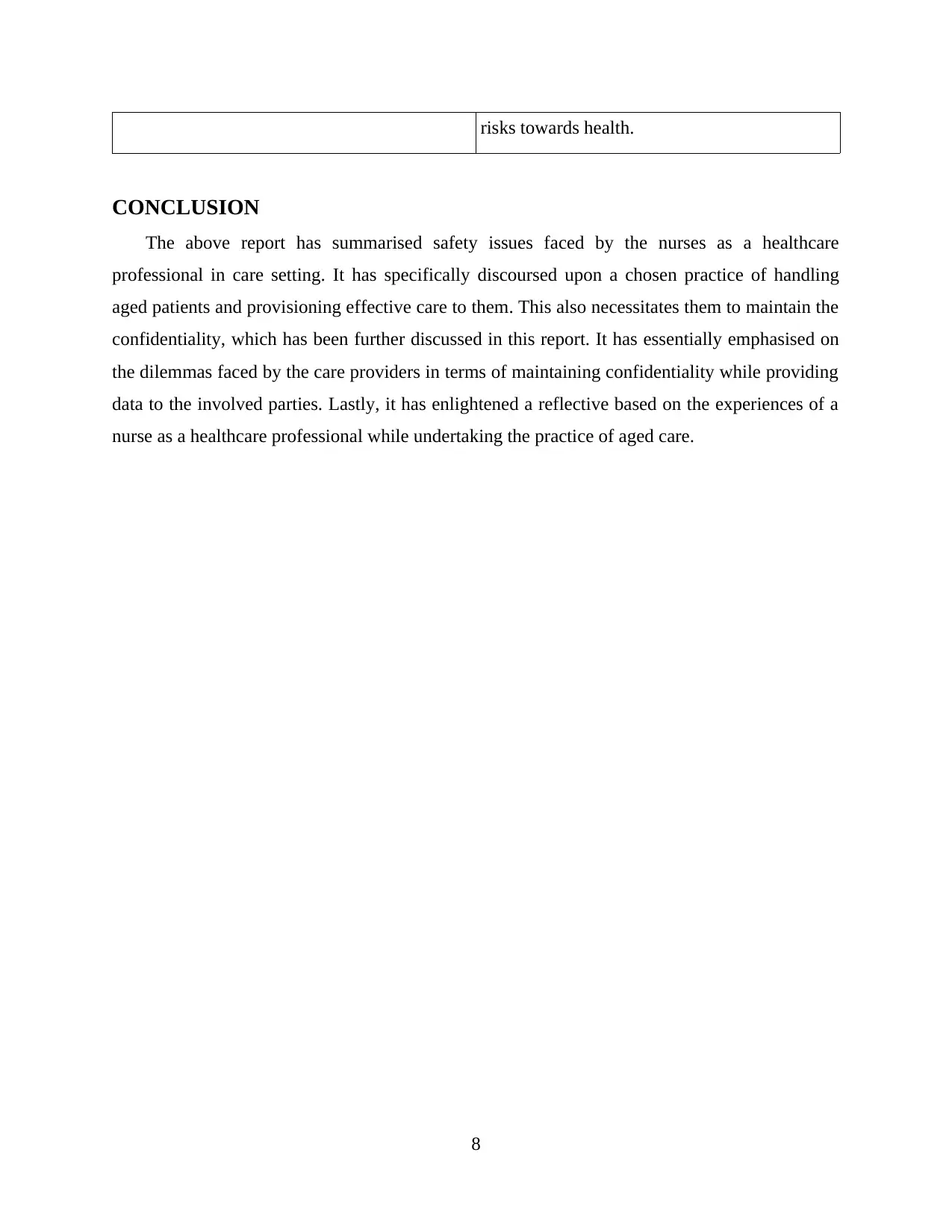
risks towards health.
CONCLUSION
The above report has summarised safety issues faced by the nurses as a healthcare
professional in care setting. It has specifically discoursed upon a chosen practice of handling
aged patients and provisioning effective care to them. This also necessitates them to maintain the
confidentiality, which has been further discussed in this report. It has essentially emphasised on
the dilemmas faced by the care providers in terms of maintaining confidentiality while providing
data to the involved parties. Lastly, it has enlightened a reflective based on the experiences of a
nurse as a healthcare professional while undertaking the practice of aged care.
8
CONCLUSION
The above report has summarised safety issues faced by the nurses as a healthcare
professional in care setting. It has specifically discoursed upon a chosen practice of handling
aged patients and provisioning effective care to them. This also necessitates them to maintain the
confidentiality, which has been further discussed in this report. It has essentially emphasised on
the dilemmas faced by the care providers in terms of maintaining confidentiality while providing
data to the involved parties. Lastly, it has enlightened a reflective based on the experiences of a
nurse as a healthcare professional while undertaking the practice of aged care.
8
Secure Best Marks with AI Grader
Need help grading? Try our AI Grader for instant feedback on your assignments.
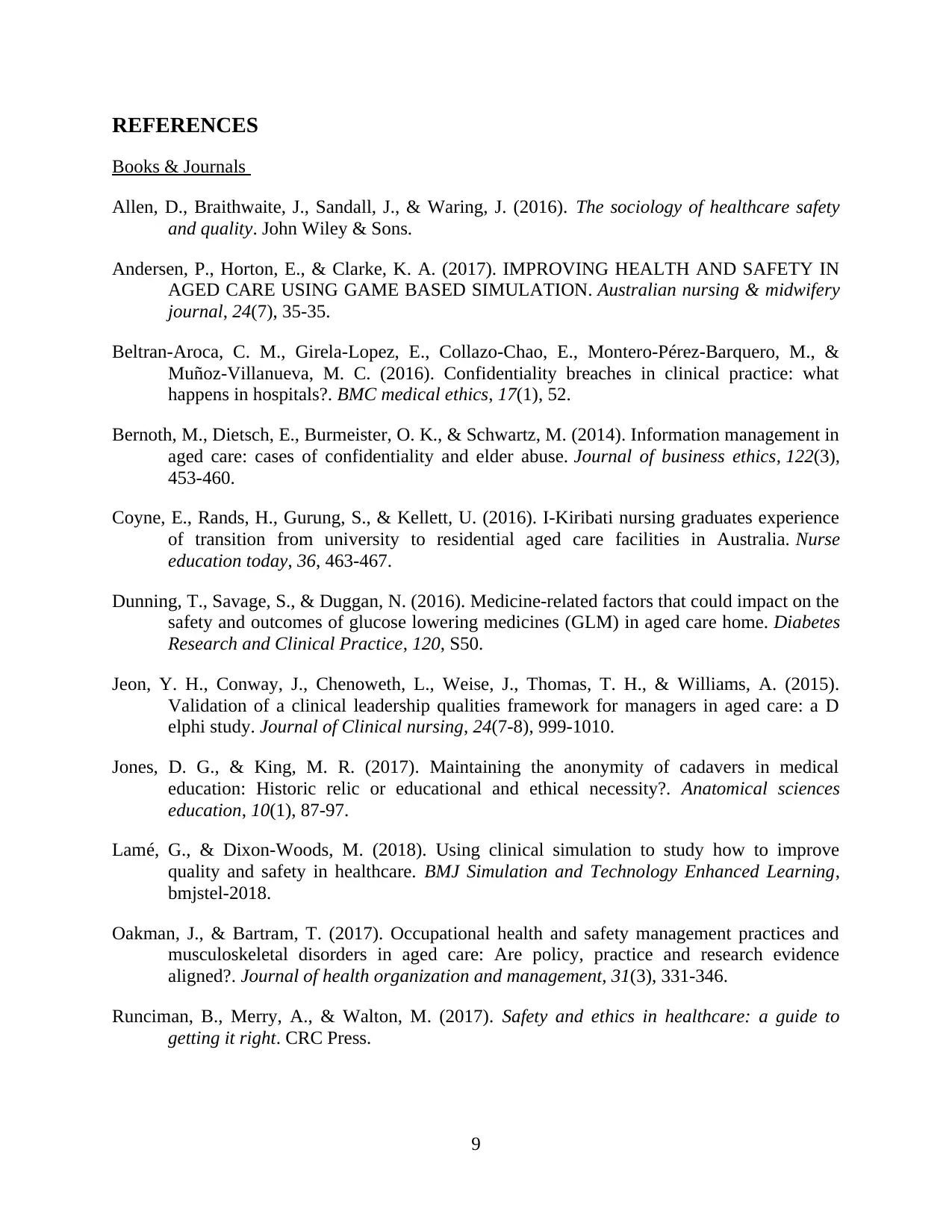
REFERENCES
Books & Journals
Allen, D., Braithwaite, J., Sandall, J., & Waring, J. (2016). The sociology of healthcare safety
and quality. John Wiley & Sons.
Andersen, P., Horton, E., & Clarke, K. A. (2017). IMPROVING HEALTH AND SAFETY IN
AGED CARE USING GAME BASED SIMULATION. Australian nursing & midwifery
journal, 24(7), 35-35.
Beltran-Aroca, C. M., Girela-Lopez, E., Collazo-Chao, E., Montero-Pérez-Barquero, M., &
Muñoz-Villanueva, M. C. (2016). Confidentiality breaches in clinical practice: what
happens in hospitals?. BMC medical ethics, 17(1), 52.
Bernoth, M., Dietsch, E., Burmeister, O. K., & Schwartz, M. (2014). Information management in
aged care: cases of confidentiality and elder abuse. Journal of business ethics, 122(3),
453-460.
Coyne, E., Rands, H., Gurung, S., & Kellett, U. (2016). I-Kiribati nursing graduates experience
of transition from university to residential aged care facilities in Australia. Nurse
education today, 36, 463-467.
Dunning, T., Savage, S., & Duggan, N. (2016). Medicine-related factors that could impact on the
safety and outcomes of glucose lowering medicines (GLM) in aged care home. Diabetes
Research and Clinical Practice, 120, S50.
Jeon, Y. H., Conway, J., Chenoweth, L., Weise, J., Thomas, T. H., & Williams, A. (2015).
Validation of a clinical leadership qualities framework for managers in aged care: a D
elphi study. Journal of Clinical nursing, 24(7-8), 999-1010.
Jones, D. G., & King, M. R. (2017). Maintaining the anonymity of cadavers in medical
education: Historic relic or educational and ethical necessity?. Anatomical sciences
education, 10(1), 87-97.
Lamé, G., & Dixon-Woods, M. (2018). Using clinical simulation to study how to improve
quality and safety in healthcare. BMJ Simulation and Technology Enhanced Learning,
bmjstel-2018.
Oakman, J., & Bartram, T. (2017). Occupational health and safety management practices and
musculoskeletal disorders in aged care: Are policy, practice and research evidence
aligned?. Journal of health organization and management, 31(3), 331-346.
Runciman, B., Merry, A., & Walton, M. (2017). Safety and ethics in healthcare: a guide to
getting it right. CRC Press.
9
Books & Journals
Allen, D., Braithwaite, J., Sandall, J., & Waring, J. (2016). The sociology of healthcare safety
and quality. John Wiley & Sons.
Andersen, P., Horton, E., & Clarke, K. A. (2017). IMPROVING HEALTH AND SAFETY IN
AGED CARE USING GAME BASED SIMULATION. Australian nursing & midwifery
journal, 24(7), 35-35.
Beltran-Aroca, C. M., Girela-Lopez, E., Collazo-Chao, E., Montero-Pérez-Barquero, M., &
Muñoz-Villanueva, M. C. (2016). Confidentiality breaches in clinical practice: what
happens in hospitals?. BMC medical ethics, 17(1), 52.
Bernoth, M., Dietsch, E., Burmeister, O. K., & Schwartz, M. (2014). Information management in
aged care: cases of confidentiality and elder abuse. Journal of business ethics, 122(3),
453-460.
Coyne, E., Rands, H., Gurung, S., & Kellett, U. (2016). I-Kiribati nursing graduates experience
of transition from university to residential aged care facilities in Australia. Nurse
education today, 36, 463-467.
Dunning, T., Savage, S., & Duggan, N. (2016). Medicine-related factors that could impact on the
safety and outcomes of glucose lowering medicines (GLM) in aged care home. Diabetes
Research and Clinical Practice, 120, S50.
Jeon, Y. H., Conway, J., Chenoweth, L., Weise, J., Thomas, T. H., & Williams, A. (2015).
Validation of a clinical leadership qualities framework for managers in aged care: a D
elphi study. Journal of Clinical nursing, 24(7-8), 999-1010.
Jones, D. G., & King, M. R. (2017). Maintaining the anonymity of cadavers in medical
education: Historic relic or educational and ethical necessity?. Anatomical sciences
education, 10(1), 87-97.
Lamé, G., & Dixon-Woods, M. (2018). Using clinical simulation to study how to improve
quality and safety in healthcare. BMJ Simulation and Technology Enhanced Learning,
bmjstel-2018.
Oakman, J., & Bartram, T. (2017). Occupational health and safety management practices and
musculoskeletal disorders in aged care: Are policy, practice and research evidence
aligned?. Journal of health organization and management, 31(3), 331-346.
Runciman, B., Merry, A., & Walton, M. (2017). Safety and ethics in healthcare: a guide to
getting it right. CRC Press.
9

Webb, B. C., Whittle, T., & Schwarz, E. (2016). Oral health and dental care in aged care
facilities in New South Wales, Australia. Part 3 concordance between residents’
perceptions and a professional dental examination. Gerodontology, 33(3), 363-372.
Wong, S. T., Lavoie, J. G., Browne, A. J., MacLeod, M. L., & Chongo, M. (2015). Patient
confidentiality within the context of group medical visits: is there cause for
concern?. Health Expectations, 18(5), 727-739.
Online
Emotional Safety. (2018). [Online]. Available through:
<https://safesupportivelearning.ed.gov/topic-research/safety/emotional-safety>.
10
facilities in New South Wales, Australia. Part 3 concordance between residents’
perceptions and a professional dental examination. Gerodontology, 33(3), 363-372.
Wong, S. T., Lavoie, J. G., Browne, A. J., MacLeod, M. L., & Chongo, M. (2015). Patient
confidentiality within the context of group medical visits: is there cause for
concern?. Health Expectations, 18(5), 727-739.
Online
Emotional Safety. (2018). [Online]. Available through:
<https://safesupportivelearning.ed.gov/topic-research/safety/emotional-safety>.
10
1 out of 12
Related Documents
Your All-in-One AI-Powered Toolkit for Academic Success.
+13062052269
info@desklib.com
Available 24*7 on WhatsApp / Email
![[object Object]](/_next/static/media/star-bottom.7253800d.svg)
Unlock your academic potential
© 2024 | Zucol Services PVT LTD | All rights reserved.




